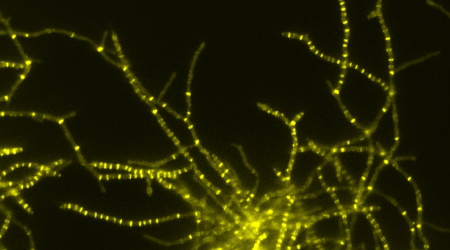How do you replace the environmentally damaging agro-chemicals that have for decades been the go-to solution for growers seeking to protect crops against bacterial and fungal attack?
Billions of pounds of damage to our major food crops is caused by soil-borne, wind-borne and insect-vectored diseases. The huge costs of this and the resultant reduction in yield is absorbed by farmers and consumers. However, John Innes Centre scientists are leading the way in exciting new collaborations to use the power of beneficial soil bacteria as a sustainable way to suppress pests and crop diseases.
The chemical pesticides and fungicides currently used are damaging the environment. Vast swathes of this chemistry-based weaponry are being withdrawn from use because they have been shown to be poisonous to pollinators, or they have harmful effects on humans.
This has brought increasing attention to so-called “biologicals” – solutions that are organic rather than chemically produced. These include biological defense systems such as soil bacteria, whose natural disease-suppressing activity can be harnessed and used against plant pathogens. It offers a solution that does not harm people, pollinators or the planet.
The problem so far is that the biologicals, despite being a huge global market of between two and three billion pounds a year, are inconsistent. “Sometimes, they haven’t worked well, or they work sometimes but not all the time. So why would people trust this over chemicals that have worked more consistently in the past?” says Dr Jacob Malone, Group Leader at the John Innes Centre.
An innovative new approach to making biologicals more consistent, targeted and adapted to local environmental conditions, has been led by the groups of Dr Malone and Dr Andrew Truman at the John Innes Centre. To develop the method, the team tested hundreds of strains of the widespread bacteria Pseudomonas from a soil sample taken from a commercial potato field. Then they sequenced the genomes of 69 of these strains.
By comparing the genomes of the strains shown to suppress pathogen activity with those that did not, the team were able to identify a key genetic mechanism that protected the crop. Then, using a combination of chemistry, genetics and plant infection experiments, they showed that the production of small molecules called cyclic lipopeptides are important to the control of potato scab.
It has been known for a long time that Pseudomonas soil bacteria produce a vast array of natural products, secreted chemicals that include antibiotics used in medicine. But while they produce a vast amount of chemistry, it’s not understood which of these chemicals are relevant for controlling a particular disease. “The approach we have taken is to examine hundreds of bacterial strains in parallel to find the patterns in suppression. We see which ones suppress and then we ask what they have in common? And that tells us which are likely to be the ones that contribute to this effect,” says Dr Malone.
The team then used a range of experiments and genomic techniques to identify the genes that are responsible for producing the natural products that lead to the beneficial effect. This answers the important scientific question of how the Pseudomonas bacteria protect the potato crop. What is unusual and exciting about this method is that it does not involve using synthetic chemistry to turn these natural products into chemical treatments.
Once the strains that produce suppressive natural products are identified, the strain of bacteria or cocktail of different suppressive bacteria strains can be applied to the crop to begin working its protective magic in the soil. Dr Truman explains, “Our long-term vision is to use the Pseudomonas strain itself to protect the crop. It’s more sustainable, it’s already happening in the soil and if we know the bacterial strain that provides the protective microbiome, we can give nature a helping hand. By using a bacterium as a treatment, you can easily grow and formulate it in an appropriate way. It is much greener than using a chemical.”
Having identified the beneficial strains and how they protect crops, the team are exploring ways of using the bacteria as a seed coating or a spray and applying it directly. Another possibility is applying it as a drip irrigation. The team have shown that irrigation causes substantial, and often beneficial, changes to the Pseudomonas population found in the soil.
Understanding how environmental factors, such as irrigation and soil type, make these bugs more or less effective in their protective function is a vital clue that can improve efficiency. Additionally, the team are also looking at developing cocktails of diverse bacterial strains, which when combined offer greater protection to the crop. “This is something we are actively exploring with our partners, particularly to translate it into the field and to apply it to different crop types with some significant success,” says Dr Truman.
One promising collaboration is with a kiwi-fruit producer in New Zealand, a company looking for an alternative to copper-based treatments used to protect crops from kiwi-fruit canker. “In this collaboration we are looking for environmentally friendly alternatives. We’ve identified and are testing some biological alternatives to the traditional treatment. They are different bugs to those in the potato-scab trials and that is the beauty of this – we can apply the same approach to almost any agricultural disease,” says Dr Malone
“Thanks to advances in high-throughput genome sequencing, we can rapidly show that the bacteria we find in the soil can have a protective effect warding off crop diseases. It’s just a matter of finding the right bug – or right combination of bugs,” says Dr Malone.
These advances in technology and a succession of academic studies over the past 10 years mean we have reached an exciting stage where academic-industry collaborations can finally enhance the role of beneficial soil bacteria as nature’s pharmacists.







